Sports Composites Market Size and Trends
The global sports composites market is estimated to be valued at USD 4.97 Bn in 2025 and is expected to reach USD 7.05 Bn by 2032, growing at a compound annual growth rate (CAGR) of 5.1% from 2025 to 2032.
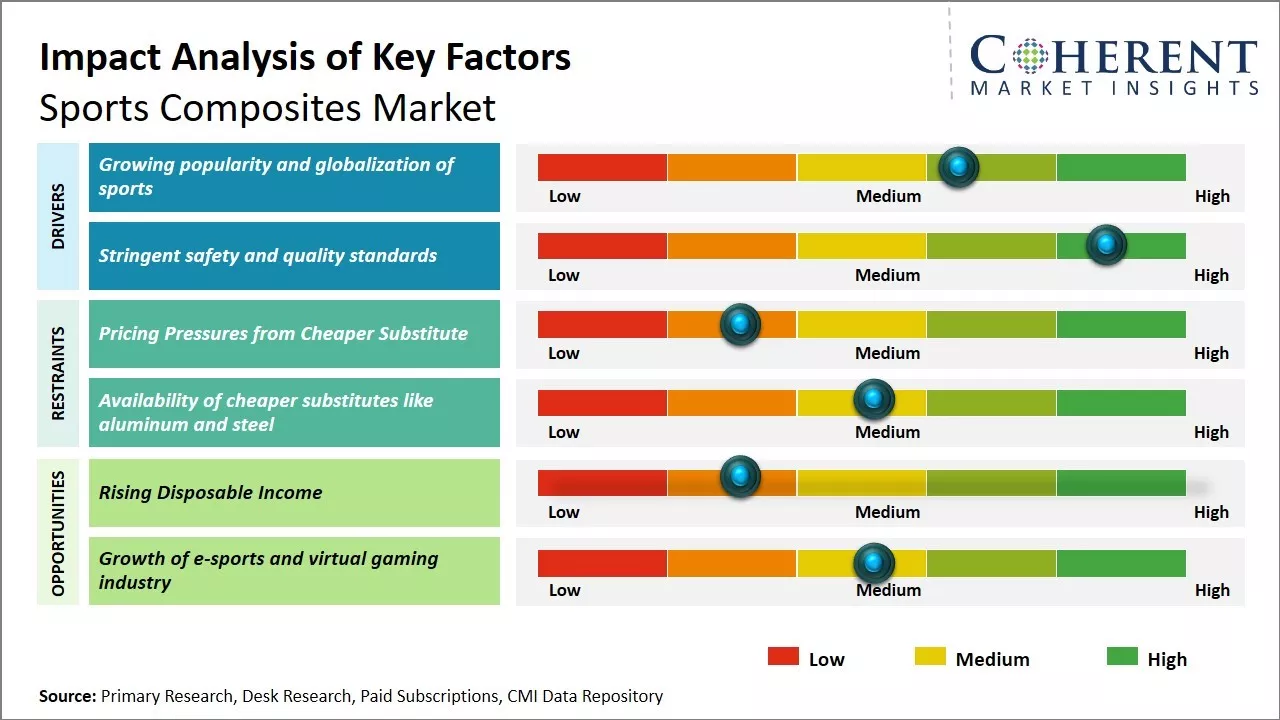
Discover market dynamics shaping the industry: Download Free Sample
The market is driven by the increasing popularity of composite materials, such as carbon fibers and glass fibers, in manufacturing sporting goods. Composite materials provide advantages such as strength, durability, design flexibility, and weight savings over traditional materials. The sports composites market trend shows the growing demand for products made with composite materials from various sports industries. Manufacturers are developing innovative composite formulations to provide performance benefits. Meanwhile, regulations supporting sustainability are increasing the usage of renewable and recyclable composites. On the demand side, health, and fitness trends continue to support participation in sports and activities, thus driving needs for high-performance gear.
Growing popularity and globalization of sports
The growing popularity of sports across the globe along with increasing sports participation has significantly propelled the demand for advanced sports equipment and accessories made from high-performance composites. For instance, on December 15, 2023, the National Football League (NFL) continued its international expansion strategy, hosting regular-season games in Germany and Mexico in addition to its established presence in London, U.K. These games attracted large crowds and significant media attention, indicating a growing international fanbase for American football. Fiber reinforced plastics and other composite materials continue to gain more foothold in various sports equipment owing to their several advantages over metals and alloys such as carbon fibers in tennis rackets that provide better ball control, spin, and precision. Moreover, rising international sports competitions and events have amplified the global exchange of sporting culture and promoted various indigenous games to worldwide audience. This has augmented the market scope of composites in sports products that are designed to withstand high stresses while remaining lightweight.
Market Concentration and Competitive Landscape
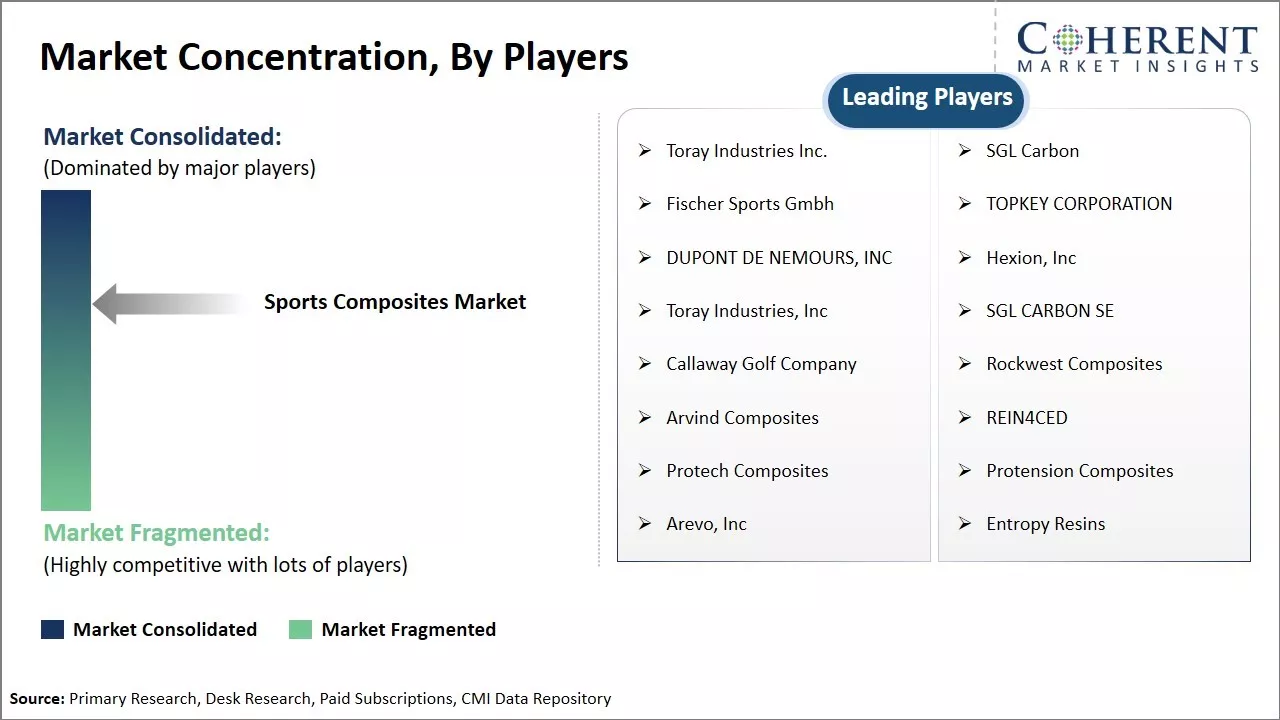
Get actionable strategies to beat competition: Download Free Sample
Stringent safety and quality standardsWith increasing competitiveness in the sports industry, athletes continuously push their physical limits which has elevated the risks of injuries. Consequently, international sports federations and governing bodies have implemented stringent quality control, testing, and certification protocols for sports equipment, devices, and safety gear used in various games and events. This has propelled the preference for composites that conform to high safety standards owing to their shock and impact absorption ability along with lightweight construction ideal for helmets, protective shells, rackets, bikes, gear, and other critical components. Furthermore, regulatory pressure on manufacturing companies towards the selection of environment-friendly and sustainably sourced materials has worked in favor of composites as an eco-friendly substitute to plastics, metals, and their alloys.
Continuous research is also undertaken to further enhance mechanical properties, durability, and performance of newly developed composite formulations. Advanced testing methods help in the rigorous assessment of composite designs under real-world stress conditions before finalizing their production and commercial roll-out. Such quality oversight and regulatory adherence by market stakeholders has strengthened the demand for stronger.
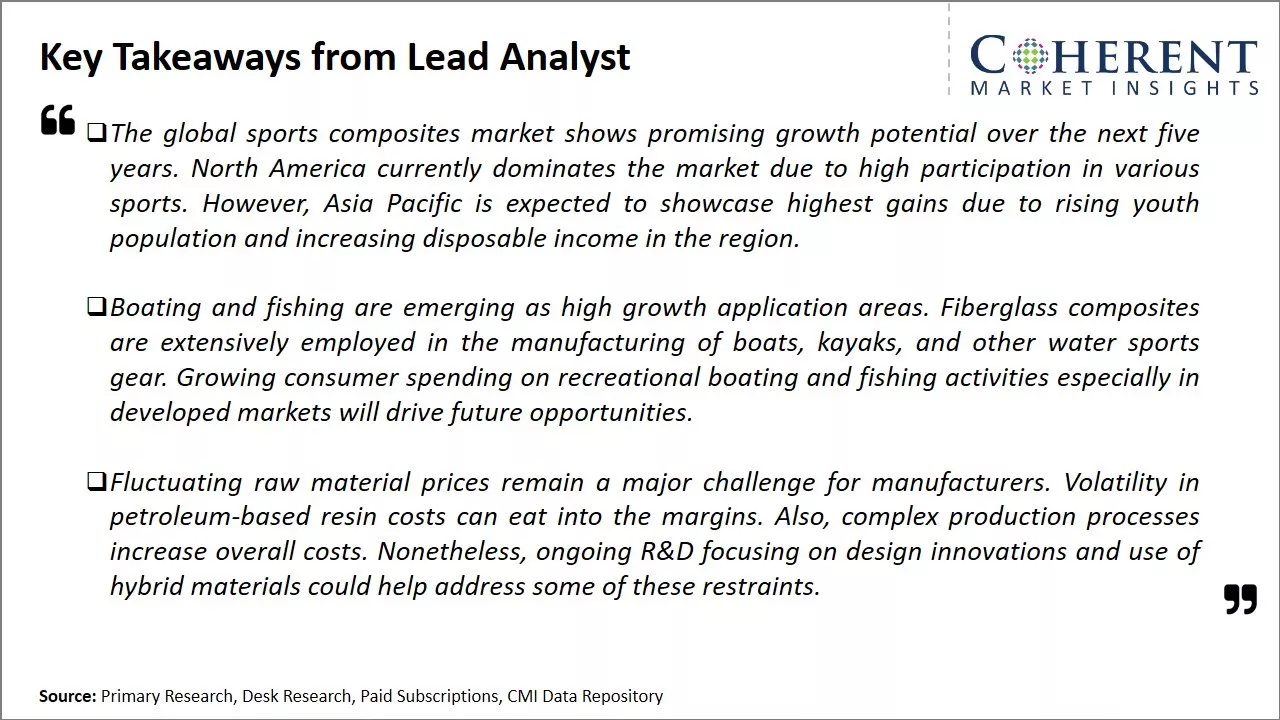
To learn more about this report, Download Free Sample
Market Challenges: Pricing Pressures from Cheaper SubstituteOne of the major challenges this market faces is pricing pressures from cheaper substitute materials like aluminum and steel. Sports composites are generally more expensive to produce than traditional materials. Another challenge is increasing environmental regulations around the world regarding the disposal of composites at end-of-life due to complex laminate construction. Maintaining equipment and molds to work with composites also requires more investment compared to other materials. Developing innovations to enhance performance characteristics while reducing costs is also challenging for manufacturers in this market.
Market Opportunities: Rising Disposable Income
The market sees strong opportunity in developing economies as participation in sports increases along with incomes in those regions. The demand for high-performance, durable, and lightweight equipment and goods continues to drive innovation. Growth in niche and extreme sports creates new avenues for composite material usage.
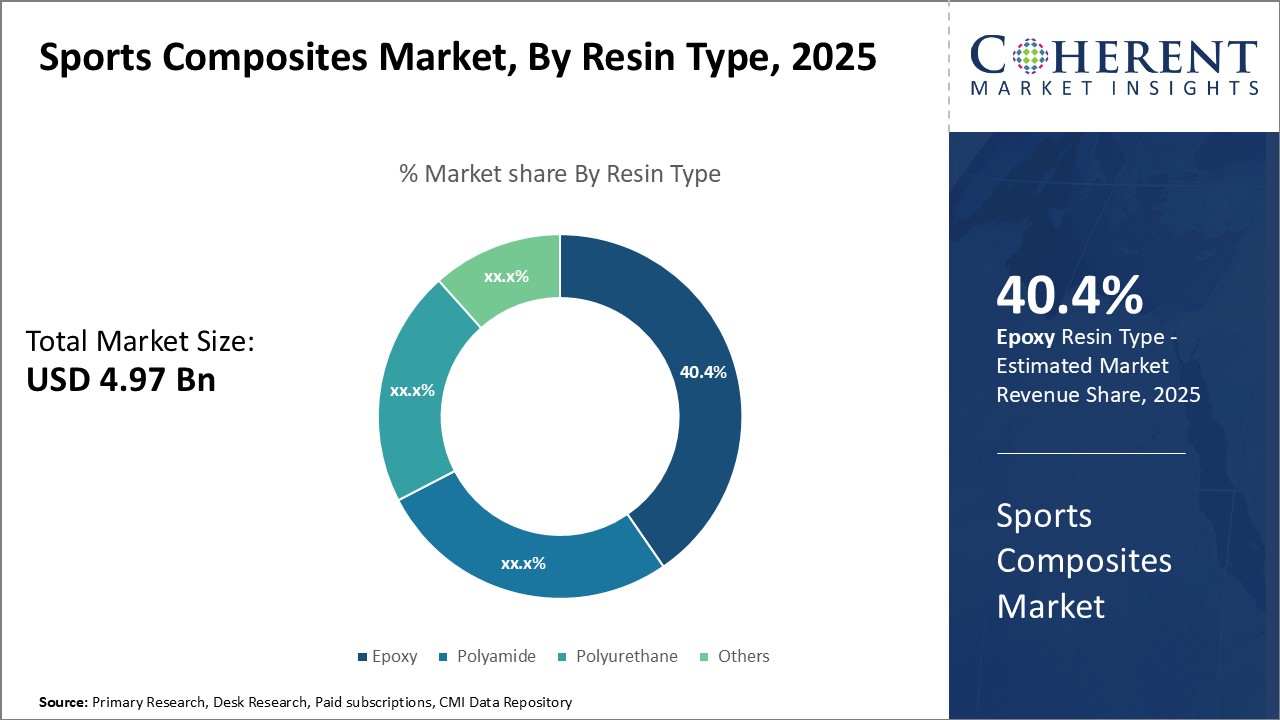
Discover high revenue pocket segments and roadmap to it: Download Free Sample
Insights, By Resin Type: Versatile Properties Drive the Epoxy Resin DemandIn terms of resin type, the epoxy segment contributes 40.4% share of the market owning to its versatile properties. Epoxy resins offer excellent adhesion, chemical, and heat resistance along with low viscosity and toxicity. These properties make epoxy composites suitable for a wide range of demanding applications in sports equipment. Epoxy composites provide strength to weight ratio, elasticity, impact resistance, and durability required in sports racquets, golf shafts, bicycles, and protective gear. Epoxy materials bond well to glass, carbon, and aramid fibers used in composite manufacturing. The fiber-resin interface ensures higher strength and rigidity of the finished composite parts compared to conventional materials. Epoxy resins also allow complex composite shapes to be molded easily using varied manufacturing techniques like vacuum infusion, prepreg molding, and RTM. These processing advantages have increased the epoxy resin usage in sports composites over other thermoset resins.
Insights, By Fiber Type: Superior Specific Properties Drive the Carbon Fiber Demand
In terms of fiber type, the carbon segment contributes 38.6% share of the market owing to its superior specific properties compared to glass and other fibers. Carbon fibers have very high tensile strength and stiffness but are extremely lightweight. The high strength to weight ratio of carbon fiber composites makes them irreplaceable for applications requiring maximum performance. Carbon composites allow designs providing optimum strength, torsional rigidity and shock absorption specific to the requirements of each sport. For example, in bicycles and golf clubs, carbon fiber ensures enhanced power transfer, feel and accuracy of shots for professional and amateur athletes. Carbon's fatigue and impact resistance also provides durability demanded in equipment subjected to repetitive stresses. Even though carbon fibers are expensive than glass, the performance benefits and design flexibility have increased their usage in high-end sports gear.
Insights, By Application: Demand for Enhanced Performance Drives the Golf Shaft Adoption
In terms of application, the golf shafts segment contributes 39.2% share of the market owing to rising demand for enhanced performance from professional and amateur golfers. Golf shaft performance strongly influences swing dynamics, ball spin, distance, and accuracy of shots. Fiber-reinforced composite shafts provide precise tuning of torque, weight distribution, stiffness and feel compared to steel or graphite shafts. Epoxy or polyamide matrix carbon fiber composites offer shaft designs optimized for each player's ability, swing, and playing conditions. Leading manufacturers employ state-of-the-art composite manufacturing to develop shaft profiles with aerospace-grade precision. This allows shafts to be tailored to maximize club head speed and power transfer for each player. The pursuit of even marginal performance gains has increased adoption of advanced composite shafts among professional golfers and enthusiasts alike.
Regional Insights
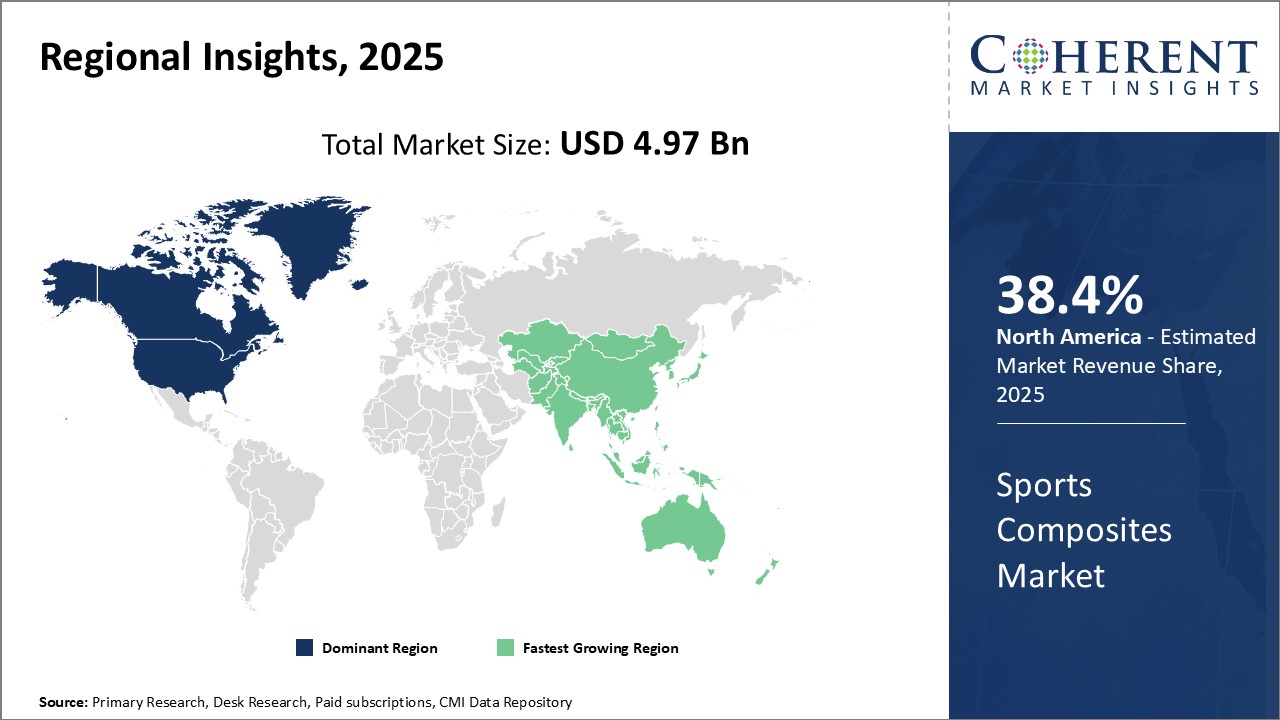
Need a Different Region or Segment? Download Free Sample
North America has firmly established itself as the dominant regional market for sports composites along with 38.4% of the market share. The region is home to some of the largest sports equipment manufacturers in the world who have been utilizing composites for decades across various sports equipment such as tennis racquets, golf shafts, bicycle frames, and protective gear. With an early mover advantage and continuous investments in R&D, North American companies have developed extensive expertise and capabilities related to composite material formulations, manufacturing techniques and engineering design support. They also actively collaborate with universities and research institutions to drive new material innovations. All these factors have enabled North American players to consistently deliver top-quality, performance-driven composite equipment and maintain a clear technology leadership globally.
Asia Pacific has emerged as the fastest growing regional market for sports composites in recent years. Rapid economic development, rising standards of living and increased participation in sports have fueled the demand for high-performance gear across countries like China, Japan, South Korea, and India. At the same time, local governments and regulatory bodies in Asia Pacific have introduced policies to promote domestic composites manufacturing capabilities through initiatives like trade incentives, skill development programs, and production-linked incentives. This is encouraging global OEMs as well as new local players to invest extensively in Asia Pacific, helping develop a robust supply chain infrastructure and an able and cost-competitive workforce skilled in composites production. In addition, Asia's status as a manufacturing hub means companies can leverage the existing industrial ecosystem and raw material access to successfully commercialize innovative composite technologies and solutions for both local and export markets. Owing to these factors, Asia Pacific is expected to significantly expand its share in the global sports composites industry over time.
Market Report Scope
Sports Composites Market Report Coverage
| Report Coverage | Details | ||
|---|---|---|---|
| Base Year: | 2024 | Market Size in 2025: | USD 4.97 Bn |
| Historical Data for: | 2020 To 2024 | Forecast Period: | 2025 To 2032 |
| Forecast Period 2025 to 2032 CAGR: | 5.1% | 2032 Value Projection: | USD 7.05 Bn |
| Geographies covered: |
|
||
| Segments covered: |
|
||
| Companies covered: |
Toray Industries Inc., SGL Carbon, Fischer Sports Gmbh, TOPKEY CORPORATION, DUPONT DE NEMOURS, INC, Hexion, Inc, Toray Industries, Inc, SGL CARBON SE, Callaway Golf Company, Rockwest Composites, Arvind Composites, REIN4CED, Protech Composites, Protension Composites, Arevo, Inc, Entropy Resins |
||
| Growth Drivers: |
|
||
| Restraints & Challenges: |
|
||
Uncover macros and micros vetted on 75+ parameters: Get instant access to report
Sports Composites Industry News
- In February 2022, Celanese Corporation declared the acquisition of DuPont's Mobility & Materials (M&M) business for USD 11.0 billion. This acquisition expanded the company’s product portfolio.
- In May 2021, Toray Industries, Inc. developed thermoplastic pellets with high tensile modulus carbon fiber, making them perfect for injection molding using that fiber. It is anticipated that the pellets will make it possible to produce complicated, lightweight parts more efficiently, which will lessen the impact on the environment.
- In January 2021, SGL Carbon announced that it will be launching an expansion project at its Arkadelphia, AR factory for USD 4.5 million in order to boost its capacity for producing carbon composites. By the year's end, the expansion is anticipated to be operational. 31 production sites are run by SGL Carbon across North America, Europe, and Asia Pacific. It is anticipated that this development would accelerate the sports composites market growth.
Definition: The global sports composites market manufactures and supplies sports equipment composed of composite materials including carbon fiber, glass fiber, aramid fiber, and others. These materials are used to produce strong and lightweight equipment including tennis rackets, fishing rods, baseball bats, golf clubs, and bicycles, windsurf boards, surfboards, kayaks, and protective gear with superior strength-to-weight ratios over traditional materials like wood and metal.
Market Segmentation
- Resin Type Insights (Revenue, USD Bn, 2020 - 2032)
- Epoxy
- Polyamide
- Polyurethane
- Others (Polypropylene, etc.)
- Fiber Type Insights (Revenue, USD Bn, 2020 - 2032)
- Glass
- Carbon
- Other Fiber Type
- Application Insights (Revenue, USD Bn, 2020 - 2032)
- Golf Shafts
- Hockey Sticks
- Rackets
- Bicycles
- Others (Skis and Snowboards, etc.)
- Regional Insights (Revenue, USD Bn, 2020 - 2032)
- North America
- U.S.
- Canada
- Latin America
- Brazil
- Argentina
- Mexico
- Rest of Latin America
- Europe
- Germany
- U.K.
- Spain
- France
- Italy
- Russia
- Rest of Europe
- Asia Pacific
- China
- India
- Japan
- Australia
- South Korea
- ASEAN
- Rest of Asia Pacific
- Middle East & Africa
- GCC Countries
- Israel
- Rest of Middle East & Africa
- North America
- Key Players Insights
- Toray Industries Inc.
- SGL Carbon
- Fischer Sports Gmbh
- TOPKEY CORPORATION
- DUPONT DE NEMOURS, INC
- Hexion, Inc
- Toray Industries, Inc
- SGL CARBON SE
- Callaway Golf Company
- Rockwest Composites
- Arvind Composites
- REIN4CED
- Protech Composites
- Protension Composites
- Arevo, Inc
- Entropy Resins
Share
Share
About Author
Yash Doshi is a Senior Management Consultant. He has 12+ years of experience in conducting research and handling consulting projects across verticals in APAC, EMEA, and the Americas.
He brings strong acumen in helping chemical companies navigate complex challenges and identify growth opportunities. He has deep expertise across the chemicals value chain, including commodity, specialty and fine chemicals, plastics and polymers, and petrochemicals. Yash is a sought-after speaker at industry conferences and contributes to various publications on topics related commodity, specialty and fine chemicals, plastics and polymers, and petrochemicals.
Missing comfort of reading report in your local language? Find your preferred language :
Transform your Strategy with Exclusive Trending Reports :
Frequently Asked Questions
EXISTING CLIENTELE
Joining thousands of companies around the world committed to making the Excellent Business Solutions.
View All Our Clients
